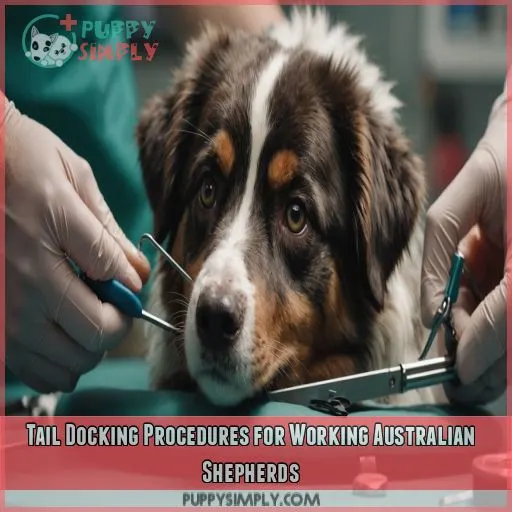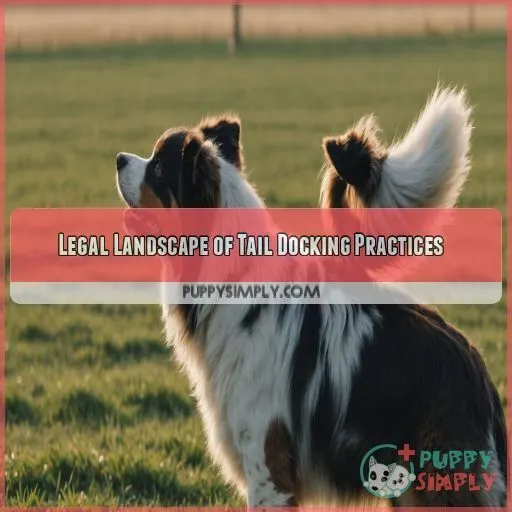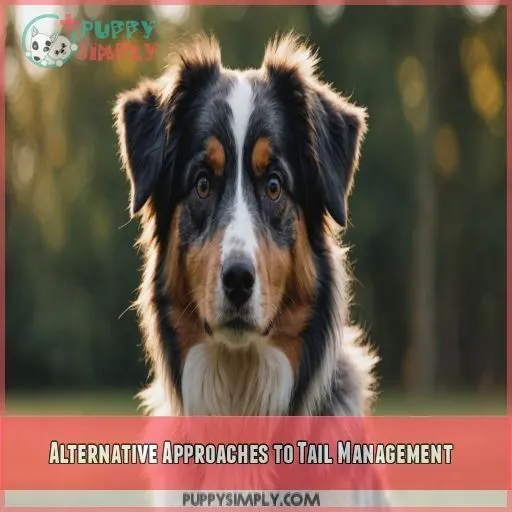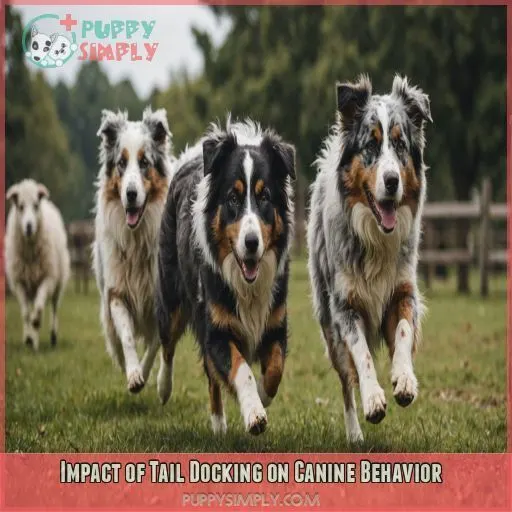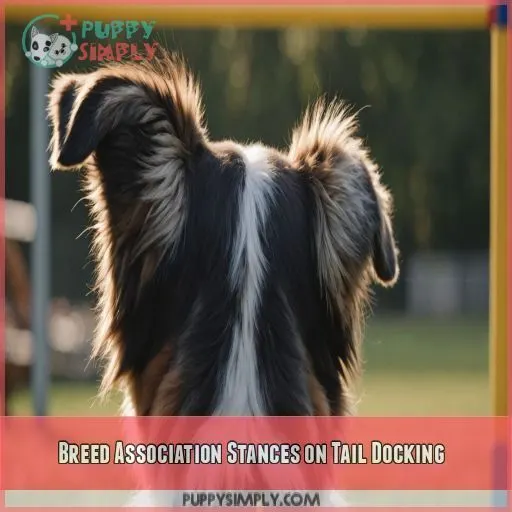This site is supported by our readers. We may earn a commission, at no cost to you, if you purchase through links.
 Australian Shepherd tail docking for working dogs is a hot-button issue that’s got tails wagging in the dog world.
Australian Shepherd tail docking for working dogs is a hot-button issue that’s got tails wagging in the dog world.
Historically, it was done to prevent injuries during herding, but nowadays, it’s a bit of a mixed bag.
While some swear by its benefits for agility and hygiene, others argue it’s unnecessary and potentially harmful.
You’ll find passionate folks on both sides of the fence!
The practice is still common in some countries, but many have put the kibosh on cosmetic docking.
If you’re considering it for your Aussie, remember that laws vary, and there are alternatives to explore.
Ready to dig deeper into this tail-wagging tale?
Table Of Contents
- Key Takeaways
- Historical Context of Australian Shepherd Tail Docking
- Genetic Factors in Australian Shepherd Tail Length
- Tail Docking Procedures for Working Australian Shepherds
- Benefits of Tail Docking for Working Dogs
- Controversies Surrounding Australian Shepherd Tail Docking
- Legal Landscape of Tail Docking Practices
- Alternative Approaches to Tail Management
- Impact of Tail Docking on Canine Behavior
- Breed Association Stances on Tail Docking
- Future Outlook for Australian Shepherd Tail Practices
- Frequently Asked Questions (FAQs)
- Should Australian Shepherds tails be docked?
- Should working dogs have their tails docked?
- What is the standard tail docking for Australian Shepherds?
- Can you register an Australian Shepherd with a tail?
- How does tail docking affect an Aussies balance?
- Can docked tails regrow or need further trimming?
- Are there specific tail lengths for different work types?
- How does tail docking impact breeding value?
- What are the age restrictions for tail docking?
- Conclusion
Key Takeaways
- You’re in for a tail-wagging debate! Tail docking is a hot-button issue with passionate arguments on both sides. While some argue it prevents injuries in rough terrain, others claim it’s unnecessary and potentially harmful. It’s like choosing between a long or short haircut, but with much more controversy!
- You’ll want to familiarize yourself with the legal landscape. Regulations vary widely between countries and even states. In some places, it’s prohibited, while others make exceptions for working dogs. It’s a bit like navigating a doggy obstacle course – you’ve got to know the rules before you jump in.
- Your Aussie’s tail isn’t just for looks – it’s their furry flag of communication. Docking can impact how they express themselves to other dogs and even affect their balance. Think of it as taking away their emoji keyboard – they might need to find new ways to get their point across.
- You’ve got options beyond the snip. From breeding for natural bobtails to using tail protection gear, there are alternatives to consider. It’s like choosing between a raincoat or an umbrella – different tools for the same job of keeping your pup safe and happy.
Historical Context of Australian Shepherd Tail Docking
You might be surprised to learn that the Australian Shepherd’s tail has been a hot topic since the breed’s early days. As we explore the historical context of Aussie tail docking, you’ll discover how working dog needs and evolving breed standards have shaped this controversial practice.
Origins of the Australian Shepherd Breed
You might think Australian Shepherds hail from Down Under, but their roots are firmly planted in the American West.
These versatile herders were born on ranches, where their keen instincts and boundless energy made them indispensable.
Despite their name, Aussies are as American as apple pie, shaped by the needs of cowboys and ranchers.
Their development was a true melting pot of various herding breeds, creating the hardworking, intelligent dogs we see today.
Early Breed Standards and Tail Preferences
As you explore the history of Australian Shepherds, you’ll discover that early breed standards emphasized the natural bobtail. This preference was rooted in the breed’s origins as a working dog. Here are three key facts about early breed standards:
- Bobtail emphasis: The first written breed standard (1959) preferred natural bobtails.
- Docking rationale: Breeders sought uniformity in tail length.
- Conformity pressures: Full tails were initially considered a disqualification in conformation rings.
Evolution of Tail Docking Practices
As you explore the evolution of tail docking practices in Australian Shepherds, you’ll discover that this procedure has been shaped by the breed’s history and working dog requirements. The practice originated from the need to prevent injuries while herding livestock . Over time, breeders adopted tail docking as a standard practice to conform to breed standards .
Influence of Working Dog Requirements
As you explore the evolution of tail docking practices, it’s clear that working dog requirements played a significant role. Herding and agility demands in rugged terrain led to concerns about injuries and hygiene. To mitigate these risks, tail docking became a common practice among Australian Shepherd breeders, prioritizing function over form and dog communication.
Genetic Factors in Australian Shepherd Tail Length
When you’re learning about Australian Shepherds, understanding the genetic factors behind their tail length can help you appreciate the breed’s unique characteristics. The T-gene mutation plays a significant role in determining whether your Aussie will have a natural bobtail or a full-length tail, and grasping these inheritance patterns can inform your breeding or buying decisions.
T-gene Mutation and Natural Bobtails
You’re interested in the T-gene mutation and natural bobtails in Australian Shepherds. This genetic variation results in a shortened tail, but the length can vary . Breeding for bobtails raises ethical implications and health considerations. Here are some key points to keep in mind:
- The T-gene mutation is a naturally occurring phenomenon .
- Natural bobtails can vary in length, from almost nonexistent to full-length .
- Breeding for bobtails increases the risk of spinal defects and other health issues (Source).
- Responsible breeding practices prioritize the health and well-being of the dogs .
Inheritance Patterns of Tail Length
Let’s break down the inheritance patterns of tail length in Australian Shepherds. If your Aussie inherits the T-gene from both parents, they’ll likely have a bobtail (Source). But if they inherit it from just one parent, they might’ve a full-length tail . It’s all about the combination of homozygous and heterozygous genes, which determines the tail length .
Variability in Bobtail Expressions
As you explore the fascinating world of Australian Shepherd tail genetics, you’ll discover that bobtail expressions can vary a lot. Here are some key variations to keep in mind:
- Length: From almost nonexistent to nearly full-length
- Shape: Straight, curved, or kinked
- Fluff: Some bobtails are feathered, while others are sleek
- Flexibility: Some bobtails are stiff, while others are flexible
- Symmetry: Bobtails can be symmetrical or asymmetrical
Full-Length Tails in Australian Shepherds
If your Australian Shepherd inherits the T-gene from only one parent, it may have a full-length tail. It’s interesting to note that around 80% of Aussies are born with full tails. Full-length tails in working dogs can be beneficial for balance and communication, but may also pose a risk for injury. Regular grooming and check-ups can help maintain tail health.
Tail Docking Procedures for Working Australian Shepherds
As you consider tail docking for your working Australian Shepherd, you need to understand the common techniques, best age, and aftercare to make sure your dog has a smooth and safe experience. By exploring the different methods and best practices, you’ll be better equipped to make an informed decision about this often-controversial procedure.
Common Docking Techniques
If you’re thinking about tail docking, you want to know what to expect. There are two common docking techniques: surgical and non-surgical. Surgical docking uses scissors, a scalpel, or a laser to remove the tail, while non-surgical methods use a rubber band to constrict blood flow. Your vet will choose the best method for your Aussie.
Optimal Age for Tail Docking
Timing is everything when it comes to tail docking for your Australian Shepherd. Veterinarians typically recommend docking between 3-5 days old, when the pup’s nervous system is still developing. This age range helps minimize pain and stress. Here are three things to keep in mind:
- Less is more: The sooner, the better to reduce discomfort and complications.
- Choose a pro: Only a skilled veterinarian should perform the procedure.
- Prepare for recovery: Your pup will need TLC to heal properly.
Anesthesia and Pain Management
You’re considering tail docking for your working Australian Shepherd. Let’s talk anesthesia and pain management. Your vet will likely use general anesthesia to minimize pain and discomfort. You should discuss anesthesia risks and pain relief options with your vet.
| Anesthesia Risks | Pain Relief Options | Vet Expertise |
|---|---|---|
| Respiratory problems | Medication | Board-certified anesthesiologist |
| Cardiac issues | Alternative therapies | Experience with similar procedures |
| Allergic reactions | Monitoring | Knowledge of breed-specific needs |
| Age-related complications | Follow-up care | Staying up-to-date with best practices |
Post-Procedure Care and Healing
After your Australian Shepherd’s tail docking procedure, it’s really important to focus on post-procedure care and healing. Your vet will provide personalized guidance, but here are some general tips:
- Monitor for infection: Keep an eye out for signs of infection, such as redness, swelling, or discharge.
- Manage pain: Follow your vet’s pain management plan to make sure your dog is comfortable.
- Restrict activity: Limit exercise and playtime to prevent irritation and promote healing.
- Maintain wound care: Clean and dress the wound as directed to support a smooth recovery.
Benefits of Tail Docking for Working Dogs
As you consider the benefits of tail docking for your working Australian Shepherd, you’re likely weighing the pros and cons of this contentious practice.
By docking your dog’s tail, you may be able to prevent injuries in rough terrain.
You may also improve their agility and maneuverability.
Tail docking can even address hygiene concerns that come with herding.
All of these benefits come while conforming to traditional breed standards.
Injury Prevention in Rough Terrain
When working with your Australian Shepherd in rough terrain, injury prevention is key.
Consider tail protection gear to safeguard against accidental damage.
Terrain-specific training can also help your dog navigate challenging environments.
Don’t forget foot care and protection – a critical aspect of overall health.
Improved Agility and Maneuverability
As you consider tail docking for your working Australian Shepherd, think about the agility benefits. A shorter tail can help your dog navigate obstacle courses with ease, making them a pro at herding agility. While it’s not a requirement for conformation shows, it can give your dog an edge in working dog competitions, where agility and maneuverability matter.
Hygiene Considerations for Herding Dogs
When you’re working with herding dogs like Australian Shepherds, hygiene is a top concern. Their tails can get caked with mud and manure, making cleaning a real challenge. Tail docking can help reduce the risk of infections and allergies. By shortening the tail, you’re also reducing the amount of dirt and debris that accumulates, making grooming a whole lot easier.
Conformity to Breed Standards
You want to make sure your Australian Shepherd matches up to breed standards, but is tail docking necessary? Historically, breed standards favored natural bobtails, but as the breed changed, so did the standards. Here are four key points to keep in mind:
- Early breed standards: Natural bobtails were preferred, but not required.
- 1960s shift: Breed standards started emphasizing uniformity, leading to more tail docking.
- Modern trends: Many breeders now favor natural tails, citing Animal Welfare concerns.
- Conformation shows: Docked tails are still common, but natural tails are gaining acceptance.
Controversies Surrounding Australian Shepherd Tail Docking
When you’re thinking about getting an Australian Shepherd, you’re likely to run into the topic of tail docking.
It’s a hot-button issue that has breeders, vets, and dog owners arguing.
In this article, we’ll dive into the controversies surrounding Australian Shepherd tail docking, looking at the animal welfare concerns, potential complications, and how it affects how dogs communicate.
All of this makes people wonder if tail docking is really necessary.
Animal Welfare Concerns
As you weigh the benefits of tail docking, consider the animal welfare concerns. Critics argue that docking impairs natural communication and can lead to behavioral changes. Many veterinarians and animal welfare organizations oppose docking for non-therapeutic reasons, citing ethics and the availability of alternatives. Legislation is also shifting, with some countries banning the practice altogether .
Pain and Potential Complications
Tail docking is something that probably has you worried about your Aussie’s pain and potential issues.
And rightfully so! Docking can be painful, especially if it’s done without proper anesthesia or at the wrong age.
Infection risk, healing time, and tail sensitivity are all things to think about.
As a responsible owner, you need to weigh these risks against any perceived benefits for your working dog.
Loss of Natural Communication Methods
When you dock an Australian Shepherd’s tail, you’re potentially cutting off more than just a piece of their body – you’re altering their language. Tail-wagging is a key part of canine communication, conveying emotions like happiness and alertness. By removing this important tool, you may be hindering their ability to convey social cues and interact with their herd.
Ethical Debates in Veterinary Communities
As a responsible dog owner, you’re likely torn between tradition and animal welfare. Veterinarians are too, sparking heated debates within the community. Some argue that tail docking is a necessary evil for working dogs, while others claim it’s an outdated practice that prioritizes aesthetics over animal well-being. Informed consent and species-specific care are at the forefront of these discussions.
Legal Landscape of Tail Docking Practices
You’re about to explore the legal landscape of tail docking practices for Australian Shepherds, where the rules differ greatly depending on the country and region you’re in. As a responsible dog owner or breeder, it’s important to understand the regulations, exceptions, and veterinary guidelines surrounding this controversial practice to make informed decisions for your working dogs.
Regulations in Different Countries
As you explore the laws surrounding tail docking, you’ll notice a patchwork of regulations across the globe. Here are a few examples:
- In Europe, many countries have banned tail docking for non-therapeutic reasons.
- In the US, laws vary by state, with some allowing docking for working dogs.
- In Australia, tail docking is restricted to certain breeds and requires veterinary approval.
- Some countries, like Sweden, have outlawed tail docking altogether, citing animal welfare concerns.
Exceptions for Working Dogs
When it comes to working dogs, some countries make exceptions to their tail docking regulations. For instance, in the UK, working dogs are exempt from the tail docking ban, but only if they’re used for specific purposes like herding or agility. Similarly, in Australia, working dogs are allowed to be docked, but only by a veterinarian .
Veterinary Guidelines and Restrictions
As a responsible dog owner, you want to make sure you’re following the rules.
Veterinary guidelines and restrictions on tail docking vary widely depending on the country and region.
In many places, veterinarians are only allowed to dock tails for therapeutic reasons, not cosmetic ones.
It’s important to talk to a veterinarian to understand the laws and regulations in your area.
Trends Towards Banning Cosmetic Procedures
You’re likely aware of the growing trend to ban cosmetic procedures, including tail docking, in many countries. As public perception shifts, so do the laws. Veterinary ethics and animal rights advocacy play a significant role in these changes. With each passing year, more countries face legal challenges, forcing a reevaluation of tail docking’s ethical implications.
Alternative Approaches to Tail Management
As you explore alternative approaches to tail management for your Australian Shepherd, you’ll discover that there are several options beyond docking that can help prevent injuries and promote a healthy, happy tail.
There are several options beyond docking that can help prevent injuries and promote a healthy, happy tail.
These options include selective breeding for natural bobtails, using tail protection equipment, training techniques to prevent injuries, and adapting work environments for tailed dogs.
Selective Breeding for Natural Bobtails
As you consider selective breeding for natural bobtails, remember that this approach raises ethical implications and potential health risks. While it aligns with breed standards, prioritizing genetic diversity is vital to keep the future of breeding healthy Australian Shepherds . By making informed decisions, you can promote a safer, more responsible breeding practice.
Tail Protection Equipment for Working Dogs
You want to safeguard your Aussie’s tail while they work? Consider investing in tail protection equipment, like durable sleeves or wraps, designed for working dogs. This gear shields their tail from potential hazards, ensuring their safety and your peace of mind. By using working dog gear, you’re taking proactive steps to prevent injuries and promote tail safety.
Training Techniques to Prevent Injuries
You want to protect your Aussie’s tail without sacrificing their herding instincts. Consider these training techniques:
- Practice obstacle avoidance and agility training to improve your dog’s spatial awareness and reaction time.
- Master leash handling to prevent accidental pulls on their tail.
- Incorporate herding drills that promote gentle, controlled movements, reducing the risk of tail injuries.
Adapting Work Environments for Tailed Dogs
As you adapt your work environment for tailed dogs, prioritize tail protection and awareness. Modify herding techniques to prevent tail injuries, and incorporate agility training to boost your dog’s spatial awareness. Assess your working space for potential hazards and make adjustments accordingly. By being mindful of your dog’s tail, you can create a safer, more effective work environment.
Impact of Tail Docking on Canine Behavior
When considering tail docking for your working Australian Shepherd, you should think about how it might affect their behavior and interactions with the world around them.
Tail docking can impact a dog’s behavior in several ways.
It can affect their body language, psychological state, and social interactions.
Changes in Body Language Expression
When you dock your Australian Shepherd’s tail, you may notice changes in their body language expression. Here are some key differences to look out for:
- Tail-wagging is replaced with alternative excitement cues, like spinning or jumping.
- Fear signals become more subtle, relying on ear positions and facial expressions.
- Alertness cues shift from tail raises to head tilts or snout twitches.
- Tail tucking is no longer an option, so they may crouch or lower their head instead.
- Body language nuances become more complex, requiring closer attention to understand their emotions.
Potential Psychological Effects
You’re probably wondering if tail docking affects your Australian Shepherd’s mental state. Research suggests it might, potentially leading to increased anxiety, stress, and fear . This, in turn, could trigger aggression or decreased confidence. You should carefully consider these potential psychological effects when deciding whether to dock your Aussie’s tail, especially considering their emotional well-being.
Adaptation to Altered Balance
You’re wondering how your Australian Shepherd will adapt to the altered balance after tail docking. Research suggests that training adjustments can help your dog compensate for the change. However, the impact on agility and gait analysis is important to think about, as it may increase injury risks (Source). Working dog adaptations will vary, but with patience and practice, your Aussie can adjust.
Social Interactions With Other Dogs
When interacting with other dogs, your Aussie’s docked tail may affect their social cues. They might rely more on ear positions and body posture to convey emotions. However, some studies suggest that tail-wagging signals, dominance displays, and playful interactions remain intact. Herding instincts may also override any tail-related limitations, but be cautious of tail-chasing behavior in some individuals.
Breed Association Stances on Tail Docking
You’re probably wondering where the major Australian Shepherd breed associations stand on tail docking, especially if you’re considering bringing one of these amazing dogs into your life. Let’s break down the stances of the Australian Shepherd Club of America (ASCA), the United States Australian Shepherd Association (USASA), and other international breed clubs on this contentious issue.
ASCA’s Position on Tail Docking
Regarding tail docking, the Australian Shepherd Club of America (ASCA) has a clear stance. According to their guidelines, tail docking is allowed for working dogs, but with certain restrictions. Here are some key takeaways:
- The ASCA breed standard allows for both docked and natural bobtail tails.
- Docking is only permitted for working dogs, not for cosmetic purposes.
- The ASCA emphasizes the importance of ethical considerations in breeding programs.
- Breeders are encouraged to prioritize natural bobtails over docking.
- Alternative practices, such as selective breeding for natural bobtails, are also recommended .
USASA’s Preferences for Natural Bobtails
When it comes to the USASA’s preferences for natural bobtails, you’ll find a strong emphasis on preserving this unique trait. The USASA breed standard considers a full tail a serious deviation from the standard. Let’s break it down:
| Bobtail Genetics | Ethical Considerations |
|---|---|
| T-gene mutation influences tail length | Tail docking ban sparks debate |
| Natural bobtails highly valued | Herding dog needs versus welfare concerns |
| Selective breeding for bobtails | USASA prioritizes natural, undocked tails |
International Breed Club Perspectives
You’re probably wondering what other breed clubs think about tail docking. Well, let’s take a look:
- The UK’s Kennel Club has strict rules against tail docking for cosmetic reasons.
- The Australian National Kennel Club allows tail docking only for therapeutic reasons.
- The FCI (Fédération Cynologique Internationale) leaves tail docking regulations up to individual breed clubs, leading to breed standard variations .
Conformation Show Requirements
When you’re prepping your Australian Shepherd for the conformation show, it’s important to know the tail length standards. Here’s a breakdown:
| Breed Association | Tail Length Standards | Disqualification Criteria |
|---|---|---|
| ASCA | Natural bobtail preferred | Full tail |
| USASA | Natural bobtail preferred | Full tail considered a serious deviation |
| AKC | Docked or natural bobtail | No disqualification |
Future Outlook for Australian Shepherd Tail Practices
As you explore the future of Australian Shepherd tail practices, you’ll discover a shift in public opinion on cosmetic procedures like tail docking, driven by growing concerns for animal welfare. With advancements in Genetic Testing and potential changes in breed standards on the horizon, you’ll need to balance tradition with the well-being of these amazing working dogs.
Shifting Public Opinion on Cosmetic Procedures
You’re part of the shift in public opinion on tail docking for cosmetic reasons . Social media’s sparked conversations, and veterinarians are speaking out . As you weigh the pros and cons, consider:
- Ethical implications: Is tail docking necessary for working dogs?
- Animal rights: Should breed standards prioritize animal welfare?
- Breed standards: Are they outdated or still relevant?
- Social media impact: How has social media influenced consumer awareness?
Join the conversation and make an informed decision about tail docking for your Australian Shepherd.
Advancements in Genetic Testing
Genetic testing is changing the game for Australian breeders.
With predictive breeding tools, you can now peek into your pup’s DNA and map out potential tail lengths.
It’s like having a crystal ball for your dog’s genes!
But remember, with great power comes great responsibility.
Ethical implications and breed health considerations should always be at the forefront of your mind when using these cutting-edge techniques.
Potential Changes in Breed Standards
You might see breed standards evolve as attitudes shift.
The show ring could start embracing full-tailed Aussies, reflecting a growing focus on natural features.
Genetic testing advances might lead to more emphasis on health over aesthetics.
Working dog standards could adapt too, recognizing that tails don’t necessarily hinder performance.
It’s like fashion – what’s "in" changes!
Keep an eye out for these potential tweaks in the Aussie world.
Balancing Tradition With Animal Welfare
As we look to the future, balancing tradition with animal welfare in Australian Shepherd tail practices is like walking a tightrope. You’ll need to think about:
- Evolving ethical considerations
- Changing breed standards
- The importance of dog communication
- Responsible breeding practices
It’s not just about following rules; it’s about understanding your furry friend’s needs. As trends shift, you might find yourself rethinking what’s best for your four-legged companion. After all, a wagging tail tells quite a tale!
Frequently Asked Questions (FAQs)
Should Australian Shepherds tails be docked?
The tail-docking debate is a hot topic, and it’s confusing. You’ll want to think about your Aussie’s purpose and well-being. Natural bobtails are preferred, but if docking’s necessary, consult a vet. Remember, your pup’s health and happiness come first.
Should working dogs have their tails docked?
You’re faced with a tough choice. Docking working dogs‘ tails is a hotly debated topic. While some argue it prevents injuries, others say it’s unnecessary and painful. Consider your dog’s specific needs and consult a vet before deciding.
What is the standard tail docking for Australian Shepherds?
Picture a fluffy Aussie tail, wagging happily. You’ll find no standard length for docking Australian Shepherds. It’s a controversial practice, often deemed unnecessary. Many prefer natural bobtails or full tails, letting your pup’s unique genetics shine through.
Can you register an Australian Shepherd with a tail?
You’ll find that registering an Aussie with a tail depends on the organization. Some clubs, like ASCA, won’t allow it, while others may. It’s a hot topic in the breed community, so check specific registry rules.
How does tail docking affect an Aussies balance?
Tail docking can affect your Aussie’s balance. It’s like removing their ru
Can docked tails regrow or need further trimming?
Once docked, your Aussie’s tail won’t regrow. It’s a one-and-done deal. No need for touch-ups! The healing process seals the deal, leaving your pup with their new, shorter tail for life. Talk about a lasting change!
Are there specific tail lengths for different work types?
Custom tails? Terrific! You’ll find no fixed formula for working dogs‘ tail lengths. It’s more about function than fashion. Whether herding or hunting, your pup’s tail should suit its specific job, keeping it safe and efficient.
How does tail docking impact breeding value?
Tail docking doesn’t directly affect breeding value, but it can muddy the waters. You’ll miss out on seeing the natural tail genetics, which could be important for preserving breed traits. It’s like judging a book by its cover!
What are the age restrictions for tail docking?
You’ll find that tail docking is typically done when puppies are 2-5 days old. It’s a controversial practice, so check your local laws. Remember, many vets won’t perform it after 5 days due to increased risks.
Conclusion
As you’ve seen, Australian Shepherd tail docking for working dogs isn’t just black and white.
It’s a complex issue with valid arguments on both sides.
Whether you’re a breeder, owner, or enthusiast, it’s important to carefully consider the pros and cons.
Think about your dog’s specific needs, local laws, and ethical concerns.
As research evolves and attitudes shift, stay informed and open-minded.
Your Aussie’s well-being should always be the top priority, tail or no tail.



